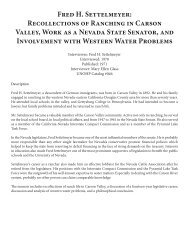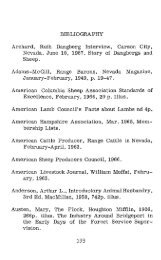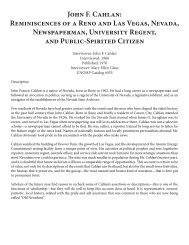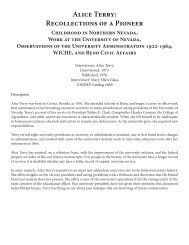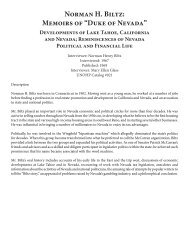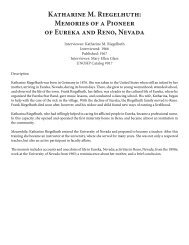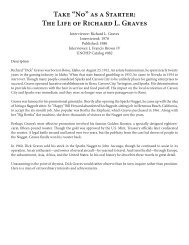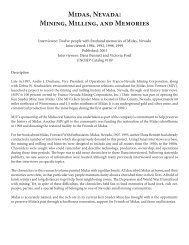Silvio Petricciani - University of Nevada, Reno
Silvio Petricciani - University of Nevada, Reno
Silvio Petricciani - University of Nevada, Reno
You also want an ePaper? Increase the reach of your titles
YUMPU automatically turns print PDFs into web optimized ePapers that Google loves.
30 <strong>Silvio</strong> E. <strong>Petricciani</strong><br />
made all <strong>of</strong> his money when he first started<br />
out. He started out with those Pace machines,<br />
and people just took to them and they went<br />
like wildfire for some reason or other. I don’t<br />
know why because mechanically they were<br />
just terrible to try to keep going. They were<br />
built very cheaply, and they’d break down all<br />
the time, but people liked them, so just fix<br />
them and let them keep on going. But even<br />
up to and including after the war, you didn’t<br />
have any electronic slot machines for a long,<br />
long time. Let’s see, Bally came out with the<br />
first electronic slot machine, well, it was in<br />
the early sixties, around ’63 I think, ’62, ’63<br />
when they first started to come out with<br />
the electronic slot machine, you know, the<br />
hoppers paying <strong>of</strong>f instead <strong>of</strong> slide pay<strong>of</strong>f and<br />
so on and so forth.<br />
So slot machines per se remained about<br />
the same except for one thing. When they<br />
first built them years and years ago, they had<br />
what they called a ten-stop reel. They had a<br />
reel with twenty figures on it, but only ten<br />
<strong>of</strong> those figures could come up. And, oh, we<br />
operated those and they were legal ins<strong>of</strong>ar<br />
as—and even the big Caille slot machines with<br />
the round dial. Percentage was set by if you<br />
played the red or the black on the dial, why,<br />
then it was strictly let it fall where it may on<br />
the cog that you would see, the geared wheel<br />
around the front. But if you played a twentyfive<br />
cent pay<strong>of</strong>f, why then there was a little<br />
lever that moved in towards the back and they<br />
had little prongs that would stick up, and it<br />
would only allow a certain number <strong>of</strong> those<br />
twenty-five cent pay<strong>of</strong>fs to hit because if the<br />
bar would come down, it would kick it <strong>of</strong>f.<br />
But this was not illegal per se because it was<br />
all figured into the percentage <strong>of</strong> the keep <strong>of</strong><br />
the slot machine—in other words, the number<br />
<strong>of</strong> coins paid out. And if the person wanted<br />
to play twenty-five cent pay<strong>of</strong>f or fifty cent<br />
pay<strong>of</strong>f or a dollar pay<strong>of</strong>f on the slot machine,<br />
then this little cog would move in and keep the<br />
percentage <strong>of</strong> the machine static. As a matter<br />
<strong>of</strong> fact my dad told me one time that with the<br />
symbols on the wheel, he said he tried it just to<br />
see what would happen if you didn’t have this<br />
cog come in. And it cost him about a hundred<br />
dollars to find out what would happen because<br />
the percentage went to the player, you see.<br />
But like I say, this was not illegal. That was no<br />
more illegal in those days than arranging the<br />
different symbols on the slot machines today<br />
to give the machine a certain percentage <strong>of</strong><br />
keep, so whether you do it with lemons or if<br />
you have a different combination <strong>of</strong> different<br />
symbols. And, <strong>of</strong> course, the Mills people also<br />
came up with what they called a twenty-stop<br />
reel which stopped with every figure, and then<br />
you figured your percentage from that point<br />
as opposed to the ten-stop reel. The ten-stop<br />
reel was kind <strong>of</strong> flukey because it would stop<br />
so abruptly, you know, instead <strong>of</strong> letting it just<br />
come into its—well, you stop twenty symbols<br />
in ten stops, why you know it s going to stop<br />
right now. Whereas now with the twenty-stop<br />
reel, now they have twenty-five- and thirtystop<br />
reels, and they have that many symbols<br />
on the reel.<br />
But when the Gaming Commission<br />
came in they said, “No, we can’t do this.” Not<br />
because it was illegal, because the percentage<br />
was right, but whatever is on the reel must be<br />
able to show up. We don’t care how tight your<br />
machine is, but whatever you symbolize must<br />
be able to show in the window on the payline.<br />
So at that time then, <strong>of</strong> course, they went to<br />
the twenty- and twenty-five- and thirty-stop<br />
reels, and then they figured their percentage<br />
from there. Of course percentages on slot<br />
machines now, today, run, oh, anywhere from<br />
ninety percent pay<strong>of</strong>f to ninety-eight percent<br />
pay<strong>of</strong>f. It all depends on—you have certain<br />
machines that are leaders, you know, and so<br />
on, and then others that—. But you can have



